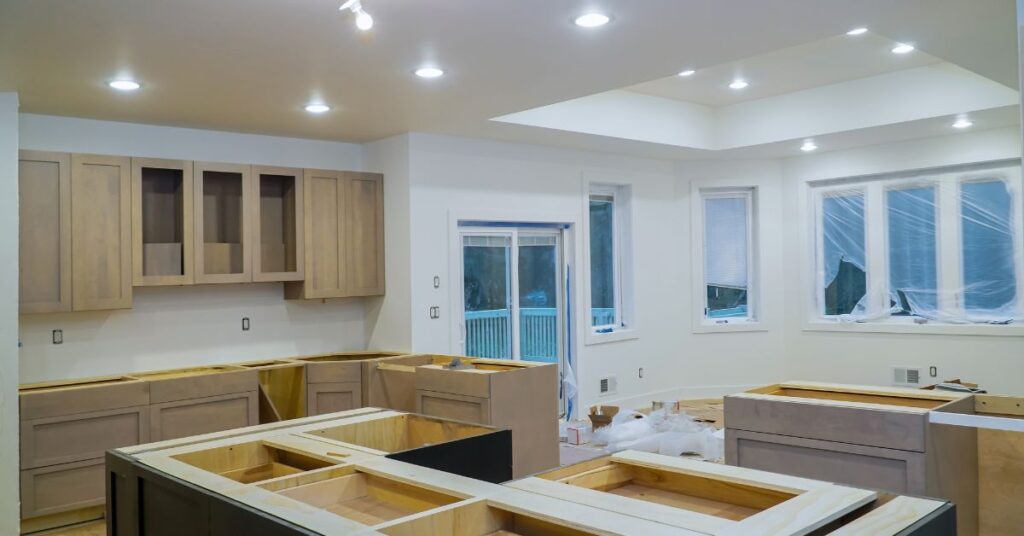Home renovations represent one of the strongest strategies to boost both your property’s worth and your everyday living experience. British homeowners possess the ability to customize their properties to match their evolving way of life thanks to renovation opportunities that span from lovely Victorian terraces to the latest new builds.
Key Reasons to Renovate or Remodel
✅ Increase Property Value
Transforming kitchens and bathrooms and turning unused lofts into functioning spaces increases property resale values. Updating lighting systems, applying new paint finishes, and installing improved flooring surfaces can make properties more attractive to prospective buyers or renters.
Example: A successful loft conversion in London can increase a property’s market value by as much as 20%.
Tip: Evaluate your Renovation’s impact on the Energy Performance Certificate (EPC) because UK buyers tend to prioritize environmental concerns.
✅ Improve Functionality
Through remodeling, you can design a home layout that matches your family’s requirements. Making practical alterations to your living space helps improve daily life whether you need to accommodate a new baby or work from home and require more storage.
Scenario: Removing walls between the kitchen and dining space creates an open-plan area that promotes sociability and meets the needs of modern families.
✅ Enhance Energy Efficiency
Residential properties of an older age typically display inadequate insulation levels alongside obsolete boiler systems and windows with only single glazing. Through Renovation, you can implement energy-efficient solutions that both cut heating costs and diminish your carbon emissions.
Upgrade suggestions:
- Triple-glazed windows
- Smart thermostats
- Underfloor heating
- Solar panels (where planning permits)
✅ Customise to Your Tastes
Your home needs to showcase your unique style and personal expression. A renovation creates an empty canvas to build your ideal kitchen space or design a spa bathroom and a minimalist bedroom loft. The renovation process allows you to integrate popular design trends, such as biophilic elements and rustic finishes, together with industrial looks.
Also Read: – What are the essential home renovation tips
What’s the Difference Between Renovating and Remodeling?
People frequently use these terms as synonyms, yet they actually refer to different scopes.
🛠️ Renovation
Focuses on restoring or updating existing structures. Examples include:
- Repainting walls
- Updating flooring
- Installing new bathroom tiles
- Replacing kitchen cabinets without changing the layout
Renovation keeps the building structure intact while enhancing its visual appeal and practical use.
🧱 Remodelling
The process of Remodelling requires changing the home’s structural layout and arrangement. Remodeling requires more intensive work and often demands both official permissions and structural changes.
Examples:
- Removing interior walls
- Converting a garage into a living space
- Building a new extension
- Changing rooflines for dormer conversions
Remodeling alters the structure of homes to accommodate evolving family needs better.
Step 1: Evaluate the Property
You need to perform a complete assessment of your home before beginning any renovation work. Ignoring this step risks creating hidden problems later, such as structural defects and moisture issues.
Checklist of What to Inspect:
- Structural Integrity: Carefully examine your property for the presence of cracks in walls or foundations, as well as tilted structural elements and roof sagging.
- Roof and Loft Space: Evaluate your roof and loft space by searching for any missing shingles and identifying damp areas as well as inadequate insulation.
- Plumbing & Electrics: Do your electrical and plumbing systems meet current UK regulation standards, or are they outdated?
- Insulation & Ventilation: Old homes need good insulation because poor insulation leads to increased energy bills.
- Space Utilisation: Do you have large hallways or box rooms that remain underutilized?
Professional Tip: A full building survey from a chartered surveyor becomes essential when dealing with homes built before 1970 or those that have listed building status.
Step 2: Define Your Goals
Your renovation project will remain focused and meet your expectations when you understand your reasons for undertaking it.
Ask Yourself:
- Do you need additional living space or improved storage options?
- Is the layout inconvenient for your lifestyle?
- What is your renovation goal—resale, rental, or long-term occupancy?
Define:
- Must-Haves: Features that you cannot compromise on include having an additional bedroom and a bathroom designed for accessibility.
- Nice-to-Haves: Features such as underfloor heating and a skylight can improve the overall experience.
- Deal Breakers: Any factor that stops you from moving forward with your plans, including budget overruns and obtaining planning permission, serves as a Deal Breaker.
Step 3: Plan Your Budget
Budgeting represents a vital step that UK homeowners frequently fail to execute correctly.
Typical UK Renovation Costs (2025 Estimates):
- Loft conversion: £25,000–£60,000
- Kitchen remodel: £10,000–£30,000
- Bathroom upgrade: £5,000–£15,000
- Full house renovation: £50,000–£150,000+
Don’t Forget:
- Planning application fees: ~£200–£500
- The fees for architects and engineers typically range from 7% to 15% of the total project cost.
- Building control inspections
- VAT at 20%
- Temporary accommodation (if needed)
- Waste removal and skip hire
💡 Golden Rule: Your budget should include a 10–20% contingency fund to cover unexpected expenses.
Step 4: Understand UK Planning Permission & Regulations
The requirements for official permissions depend on how extensive and complex your project is.
Common Requirements:
- Planning Permission: Every major building alteration or extension and all work on listed buildings must receive planning permission.
- Building Regulations: Building Regulations require structural safety measures along with specifications for fire resistance and insulation while meeting accessibility standards.
- Party Wall Agreement: A Party Wall Agreement becomes necessary for any work on mutual walls or dividing lines.
- Permitted Development Rights (PDR): Although loft conversions or single-story rear extensions often fall under Permitted Development Rights, which might not require full planning permission, it’s essential to verify with your local council.
Tip: Obtaining permissions for conservation areas or listed properties generally requires more time. Start early!
Step 5: Create a Design and Layout Plan
A solid design foundation ensures smoother execution processes, which lead to improved results.
Key Elements to Consider:
- Natural Light: Maximise brightness by installing skylights along with designing open-plan spaces and incorporating large windows.
- Storage Solutions: Built-in wardrobes, under-stairs storage, and vertical shelves.
- Traffic Flow: Ensure rooms feel connected, not cramped.
- Zoning: Organize open-plan layouts by defining functional areas such as cooking spaces and dining sections.
- Smart Tech Integration: Home automation, lighting control, and security systems.
Visualize your new layout by using digital tools such as SketchUp, Floorplanner, or Roomstyler. An interior designer can help you create mood boards and select material palettes.
Step 6: Consider LB Group for Your Renovation Partnership
The success or failure of your Renovation depends on the contractor you hire. LB Group provides high-quality renovation services throughout the UK, which guarantee stress-free experiences for clients.
Why Homeowners Trust LB Group:
- End-to-End Service: Our renovation services extend from initial planning and design phases through construction to final finishing touches.
- UK Regulation Experts: Our team manages both permissions acquisition as well as building code compliance and council approvals.
- Vetted Professionals: The LB Group team consists of trusted architects together with structural engineers and builders as well as decorators.
- Dedicated Project Manager: You will work with one contact person throughout the entire renovation process.
- Clear Communication: You will receive regular progress updates and financial status reports to stay informed.
Thinking about renovating your home? Contact LB Group today to receive a complimentary consultation and transparent pricing details.
Step 7: Get the Necessary Approvals and Certificates
Following design completion, it becomes essential to address all legal requirements.
Checklist:
- Planning Applications: Submit to your local council if required.
- Building Control Approval: Building Control Approval needs to be secured prior to starting structural or electrical construction tasks.
- Party Wall Notifications: Send official notifications to bordering neighbors at least two months prior to starting work.
The LB Group manages your approval process, which eliminates delays and possible legal problems while reducing your workload.
Step 8: Begin the Renovation Work – What to Expect
Renovation Timeline Overview:
- Site Prep & Demolition: Remove old fixtures, walls, or flooring.
- Structural Work: Install new beams, partitions, or extensions.
- First Fix: Plumbing, electrics, and initial wiring.
- Insulation & Plastering: For thermal comfort and soundproofing.
- Second Fix: Kitchen units, bathrooms, sockets, and lighting.
- Decorating & Flooring: Paint, tiles, carpets, or hardwood.
- Snagging & Cleanup: Final checks and minor fixes.
Timelines vary based on project complexity:
- Minor updates: 2–4 weeks
- Loft conversions: 6–10 weeks
- Full house renovations: 3–6 months
Step 9: Monitor Progress and Stay on Track
A great contractor does not eliminate the need for progress monitoring to maintain accountability.
Best Practices:
- Weekly Reports: Request updates with photos or videos.
- Progress Meetings: The site manager conducts weekly progress meetings either through virtual platforms or face-to-face.
- Milestone Reviews: Verify critical project phases, including initial fitting and structural construction.
- Budget Tracking: Keep track of expenses and identify any departures from planned budgets.
Steer clear of micro-managing activities yet make inquiries when the situation lacks clarity. LB Group provides dedicated project managers to be your only point of contact throughout the project.
Step 10: The Final Touches and Snag List
Conduct a site walk-through to compile a comprehensive snag list as the project concludes.
Common Issues to Watch For:
- Loose fittings
- Incomplete paintwork
- Door misalignment
- Faulty electrical sockets
- Silicone sealing around baths or sinks
Tip: Only provide your signature when you are completely satisfied with all aspects of the work. A professional snagging inspection takes place during our handover process at LB Group.
Aftercare: Maintenance, Guarantees, and Support
Your renovation partner will remain available for support even after the project has finished.
What You Should Receive:
- Completion Certificate
- Building Regulations Certificate (if applicable)
- Warranties on appliances and installations
- Instruction manuals
- Emergency contact list
LB Group provides continuous aftercare and maintenance solutions for enduring peace of mind.
Common Mistakes to Avoid
Avoid these renovation pitfalls:
- ❌ Underestimating budget – Always plan for a cushion.
- Neglecting inspections allows small problems to escalate into big ones.
- Avoid DIY repairs on essential systems such as plumbing and electrical work and rely on certified professionals instead.
- Failing to obtain proper permissions may result in penalties or mandatory reversals.
- Selecting services purely on low costs usually results in substandard work.
Final Thoughts
Home renovation acts as a dual opportunity to invest money while improving your living experience. It can be thrilling but also complex. Your dream home becomes attainable when you combine the right mindset with proper planning alongside the expertise of LB Group.
From restoring a Cotswolds cottage to modernizing a Bristol townhouse, we deliver custom renovation solutions that merge aesthetics with Functionality and regulatory compliance.
Ready to Start Your Renovation?
Trust LB Group to navigate your renovation process from concept to completion.
Please take action now by reaching out to us for a complimentary consultation with no commitments so you can begin changing your space.

Sunny Saini is a certified heating engineer with over 15 years of experience in maintaining and repairing boilers. He specializes in diagnosing complex boiler issues and providing reliable solutions to ensure homeowners stay warm and comfortable throughout the year.





![]=](https://localboiler.co.uk/wp-content/uploads/2024/05/Untitled-design-96-300x300.jpg)